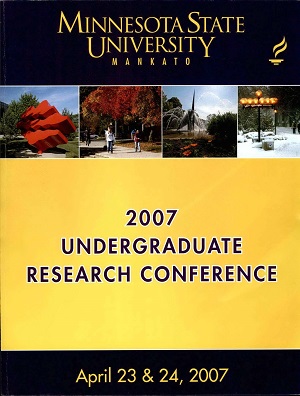Investigation of Aqueous Chromium (III) Complexation Chemistry and its Implications for a Common Laboratory Procedure
Location
CSU 253/4/5
Start Date
23-4-2007 1:00 PM
End Date
23-4-2007 3:00 PM
Student's Major
Chemistry and Geology
Student's College
Science, Engineering and Technology
Mentor's Name
Kevin J. Boyd
Mentor's Department
Chemistry and Geology
Mentor's College
Science, Engineering and Technology
Second Mentor's Name
Daniel J. Swart
Second Mentor's Department
Chemistry and Geology
Second Mentor's College
Science, Engineering and Technology
Description
A common analytical laboratory procedure is the simultaneous determination of cobalt (11) and chromium (HI) ions in aqueous solutions using visible absorption spectroscopy and spectrometry. However, it has been noticed that Cr (HI) ions in aqueous solutions freshly prepared from the chloride salt exhibit a slow yet distinct absorption shift corresponding to a color change from green to blue that takes place on a timescale of ~ 24 hours under "normal" laboratory conditions. Previous literature studies have suggested that Cr (III) complexation chemistry in an aqueous medium is quite complex. Our preliminary spectroscopic studies utilizing factor analysis have suggested that this color change is due to a multi-step reaction process involving chloride/water exchange. To date, we are unaware of any sources that have commented on the affect of this color shift on the analytical validity of this undergraduate laboratory procedure. The presented research investigates the temperature, concentration, and pH dependence of this absorption shift. This kinetic and thermodynamic data was used to elucidate the nature of the multi-step processes and structure of the proposed intermediates. While it has been assumed that Cr (HI) and Co (II) do not interact in aqueous solutions, our study also investigates the possibility that Co (II) ions may also become involved in oligomer formation when both ions are present in solution. The implications of the existence of Cr (HI) intermediates and possible Co (II) complexes for the simultaneous determination of Cr (III) and Co (H) by this procedure will be discussed.
Investigation of Aqueous Chromium (III) Complexation Chemistry and its Implications for a Common Laboratory Procedure
CSU 253/4/5
A common analytical laboratory procedure is the simultaneous determination of cobalt (11) and chromium (HI) ions in aqueous solutions using visible absorption spectroscopy and spectrometry. However, it has been noticed that Cr (HI) ions in aqueous solutions freshly prepared from the chloride salt exhibit a slow yet distinct absorption shift corresponding to a color change from green to blue that takes place on a timescale of ~ 24 hours under "normal" laboratory conditions. Previous literature studies have suggested that Cr (III) complexation chemistry in an aqueous medium is quite complex. Our preliminary spectroscopic studies utilizing factor analysis have suggested that this color change is due to a multi-step reaction process involving chloride/water exchange. To date, we are unaware of any sources that have commented on the affect of this color shift on the analytical validity of this undergraduate laboratory procedure. The presented research investigates the temperature, concentration, and pH dependence of this absorption shift. This kinetic and thermodynamic data was used to elucidate the nature of the multi-step processes and structure of the proposed intermediates. While it has been assumed that Cr (HI) and Co (II) do not interact in aqueous solutions, our study also investigates the possibility that Co (II) ions may also become involved in oligomer formation when both ions are present in solution. The implications of the existence of Cr (HI) intermediates and possible Co (II) complexes for the simultaneous determination of Cr (III) and Co (H) by this procedure will be discussed.
Recommended Citation
Ploeger, Marjorie J.. "Investigation of Aqueous Chromium (III) Complexation Chemistry and its Implications for a Common Laboratory Procedure." Undergraduate Research Symposium, Mankato, MN, April 23, 2007.
https://cornerstone.lib.mnsu.edu/urs/2007/poster-session-B/7



